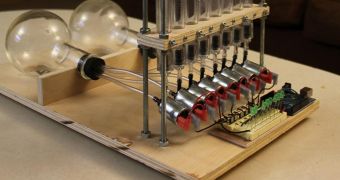There are a whole bunch of different display technologies powering today's displays, but the ones that haven't gone into use are often the most interesting.
Matt Bell's water-based display screen, if it can be called such, is probably one of the most unusual methods of creating pixels yet.
In his own words, “the idea is to build a small water tank with individually controlled solenoid valves at the bottom. By turning the solenoids on and off in specific patterns, [it should be possible to] make simple black and white images float up slowly from the bottom of a tank.”
By black and white, he means that small air bubbles create “white” pixels on a “black,” water screen. Depending on preprogrammed sequences, letters and numbers can be spelled.
The technology started out as a bunch of aquarium air hoses and pumps, some random electrical components and an Arduino Uno microcontroller.
The newest prototype keeps the water tank, the grid of clear plastic tubes and individual solenoid valves, but adds a couple of large chemistry flasks to play the part of air reservoir.
The new flasks are meant to address a problem that the initial setup had: the air bubbles were too small when all eight air valves were opened. He also added vinyl tubes for holding the liquid, replacing the large tank.
“Now when I force bubbles into the tubes they rise at a steady rate independent of the size of the bubble […]. Another thing is making sure that the bubbles are not formed too close together. There seems to a minimum gap that can exists between bubbles,” Bell wrote.
Check out the video embedded below for the bubble letters. We doubt we'll be seeing this thing used anywhere, but we doubt the world is devoid of architects that would consider building something of the sort into the walls of a building.

 14 DAY TRIAL //
14 DAY TRIAL // 